
(Click title to go directly to the review)
IVAR, TIMEWALKER #1 ALL NEW X-FACTOR #20
THE SHADOW: DEATH FACTORY #1
Indie Jones presents ORC GIRL One Shot
MANIFEST DESTINY VOL.2
MOON KNIGHT #11
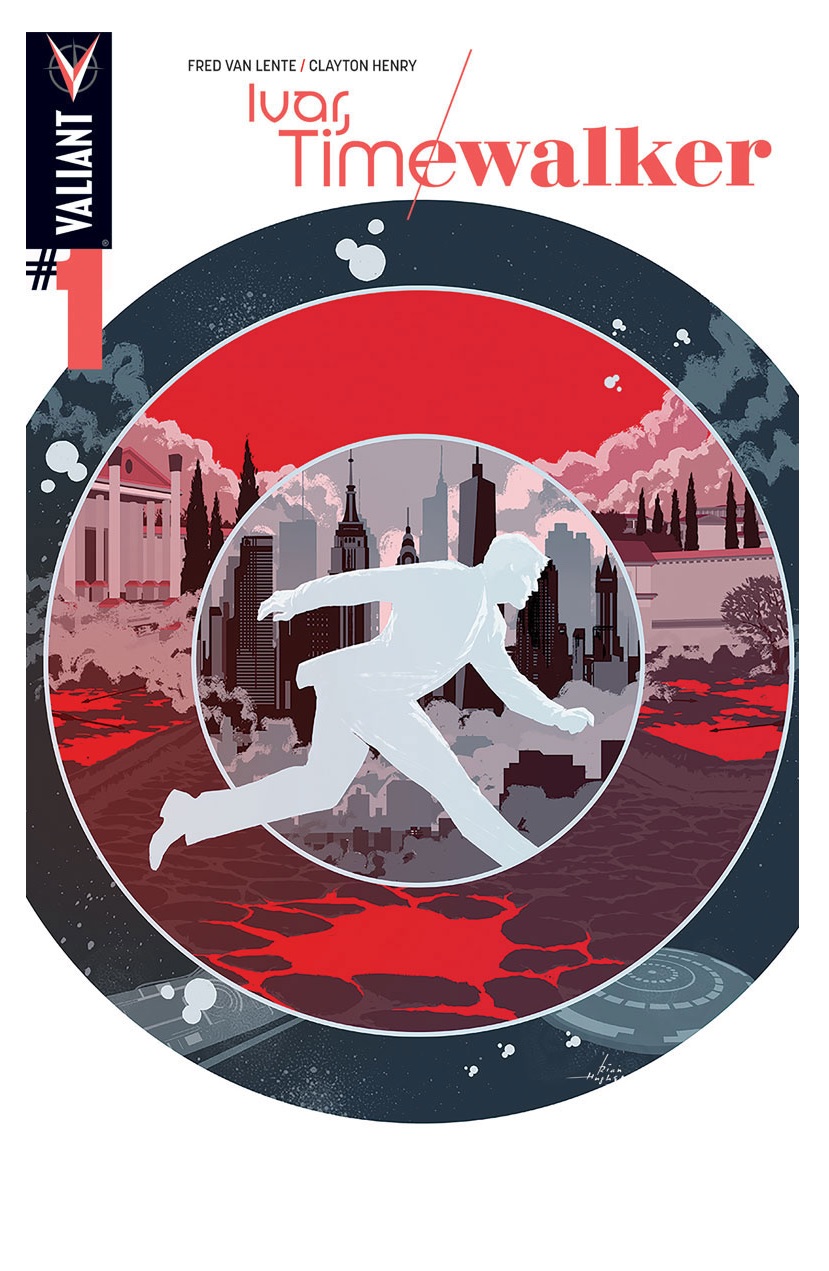
IVAR, TIMEWALKER #1
Writer: Fred Van LenteArt: Clayton Henry
Publisher: Valiant Entertainment
Reviewer: Optimous Douche
When I say IVAR, TIME WALKER #1 is just what Valiant needs right now, realize I am tainting that statement with my enormous need to be right and control the world. It is also welling from nostalgia. I don’t get lost in remember when from comics to wedding anniversaries, however--I learn from it as our leaps forward are propelled by the fuel of what was.
Ivar took a different path in Valiant 1.0, since the tempo of the universe was simply different. Shooter wanted to traverse all space and time twenty years ago with a tight intermeshing of threads and moments. Valiant 2.0 kept the watertight continuity, but kept time and space off the table until the here and now on terra firma was well-grounded with stories. When UNITY was announced a year ago, I thought for sure we were about to kick the door in on time travel and extra dimensions, since that was the focus of UNITY a generation ago. Wrong: they were an Illuminati org of the big guns: a great book that should get nary a mark for my predispositions--however, I still want what I want.
I’ve lived and breathed sci fi balanced with religious beliefs to explain this world and life we lead since I was a child. I was reading the bible and Asimov at the same time I had a copy of Richie Rich drilling a dinosaur’s brown eye for oil with Professor Keenbean. Comics have always been in the mix in this search. The Ani-Pada brothers of Valiant are the Moe, Larry and Curly of mankind’s rise (in this age) and the accidental plumbers in pushing us along our path towards ???? ESPECIALLY IVAR!!!! Armstrong and Gilad, they can only go one direction on their immortal journey till the lights go out. Ivar got the bad end of the boon in getting launched across all time to live out the beginning and the end in the same sequence as we traverse Monday to Tuesday to Kumquat X12 in the year 3,000,000,000. He’s not quite lost in time, but he certainly is stuck in a “Sliders”-style roulette wheel of choice locales…perhaps.
Going back to nostalgia, but not suffocating in it, Van Lente brings forward in a perfect “just the tip” amount the idea that Ivar, unlike his other two hero brothers, may not be on the side of angels--or worse, there are only demons in this equation. It was an idea flirted with in 1.0, but never brought to fruition as Valiant like so many universes imploded when the industry atrophied post-“Death of Superman” and Death of Decency at Image. Valiant is the true purveyor of gray villains, and they make the wise but still ballsy choice to set a title up with a character who could be trying to play God…poorly. Like Toyo Harada, Ivar may think he’s doing right, but based upon the morality of who?
Perhaps his companion, the plucky nuclear physicist that Ivar grabs from the basement of CERN a few minutes before she discovers the means to controllable time travel will become a moral compass. Geeks like geek talk. We gravitate to those with a level of gravitas for inane details and fictional fact checks. It has become the norm today to see this affliction inside the hyper-smart like the “Big Bang Theory” characters (Hell, Chuck Lore’s entire prostate is made of cultural one-liners). Ivar is given a similar gal pal to those afflicted CBS moppets, and for now it works. It’s the Dr. Who companion form of translating the fantastic through the newly initiated, but when written well works and I will watch it again. I caution Van Lente not to make her too flip, though. She understands quantum mechanics; to do that level of reading one needs to sacrifice a few Taylor Swift lyrics.
As soon as Ivar prevents her discovery the two whisk away (with some 5th dimensional baddies in pursuit) to time ports a-plenty. From the battle of Trafalgar to 4001 Japan to nosh sushi and watch Rai footage, Ivar is not only an introduction to a new power set but a lost element of Valiant from yore.
Fun and breezy, without overexerting metaphysical explanations (and cleverly debunking a few over used ones), IVAR, TIME WALKER is a worthy genesis for the next big wave of Valiant stories that take us to the ends of physical and theoretical reality. From art to story and back to art again on the cover, Valiant is grand in scope again with a meticulous eye towards detail. They didn’t have to give me a timebulls eye on the cover of this book like the opening credits of “Buck Rogers”, but the fact they did makes me love the book even more.
When Optimous isn't reviewing comics he is making the IT words chortle and groan with marketing for MaaS360, enterprise mobility management www.maas360.com. He also has a comic coming out sometime soon, for updates head to robpatey.com.
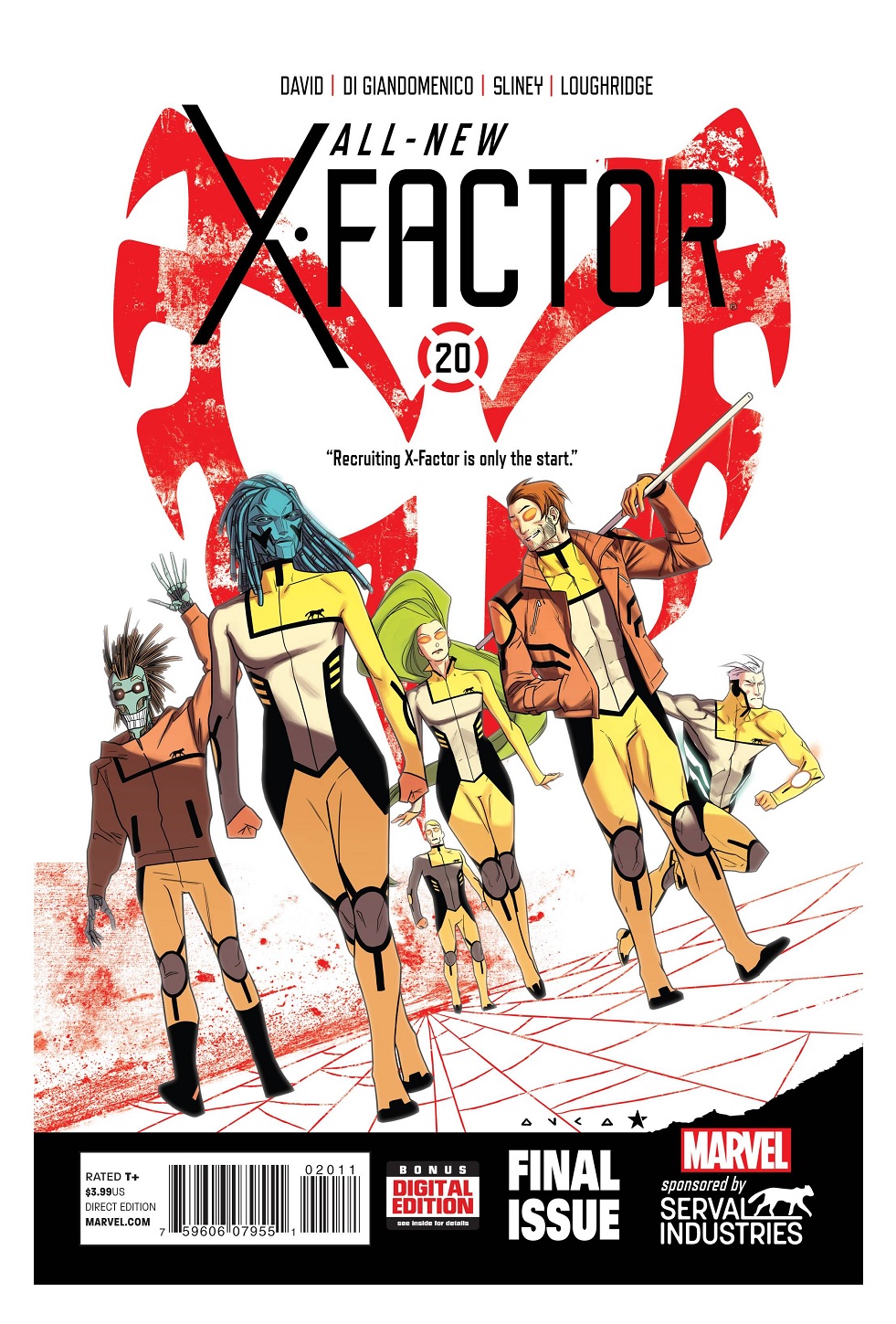
ALL-NEW X-FACTOR #20
Writers: Peter DavidArt: Carmine Di Giandomenico and Will Sliney
Publisher: Marvel Comics
Reviewer: DrSumac
In full disclosure, I likely haven't been reading comics for as long as the other contributors on this site or its readers. I started about eight years ago when my brother gave me his copy of WATCHMEN from when he used to collect in the 80s and 90s, but the first superhero series that really grabbed me was Peter David's last X-FACTOR run. It was that comic that taught me that heroes don't need to be famous to be great characters. Multiple Man actually became my favorite superhero thanks to the way Peter wrote him there. It's also my favorite Marvel series I've ever read, but of course all good things come to an end.
I get why Peter wanted to move on from that X-Factor team since things just get stale over time. The all new group also had a lot of promise, with heavy hitters like Gambit and Quicksilver backing up the more quirky members. The new plot of Serval Industries and what their CEO Harrison Snow wanted was also intriguing with a mystery all its own.
Unfortunately, the new formula just didn't seem to work as well, though. In fact, I'm tempted to say that Gambit and Quicksilver were actually part of the problem. Somehow they seemed to take away form the feeling of X-Factor as a rogue group of nobodies. Meanwhile Warlock, Cypher, and Danger never had much to do aside from running gags that should have stopped long before they did.
Actually, I really liked Polaris in the series and found her role as leader of the new team to be much more interesting than her appearances in the past. Conversely, I also hated Danger rather vehemently. I honestly didn't really care for the fact that she wanted to bang everyone, but the real sin seemed to be that she was typically able to take out most threats all on her own. It often felt like Peter just waited for the others to get tossed around before she showed up to win the day, which I know for a fact he is better than. I thought Warlock was cool and cute, but was too tied up with Danger to shine much for me. Cypher, on the other hand, didn't have much of a personality at all other than being generally good and nice.
It may have been coincidental, but I was disappointed that the team's collective skills weren't utilized more. You had a master thief, a magnekinetic, two robots, and a guy that could control machines; that team is begging to take on high tech enemies. Personally I would have loved to see them fight the likes of Mastermold, Nimrod, Ultron, Kang, or even Tony Stark himself on some level. Give the villain a creative take that evens the odds with the appearance of an overwhelming force and I think we could have had some really cool stories that gave everyone a useful role.
If Peter David does have one unique and valuable skill in the comics industry, though, it's that he is really great at ending a series, which even my favorite writers like Greg Rucka and Gail Simone seem to struggle with at times. It would have been easy to be bitter and phone this issue in, but instead he finally gave the readers what they have been looking for. Harrison Snow's motives have been fully revealed and Warlock and Danger had a moment together that could very well change both characters forever. This was the kind of ending that makes the readers want more even if they've been generally disappointed with the series. Fortunately, the story seems to be connected to the SPIDERMAN 2099 title that he is also writing, so X-FACTOR fans may want to switch books to see where it goes.
Overall, I'll always been a Peter David fan even though I was generally disappointed with this one particular series. It seems to me that this title got away from him and that just sort of happens sometimes. If he starts a new series with any publisher you can bet I'll check it out.
How did you like this comic? Please comment below or contact drsumac at drsumac.tumblr.com!
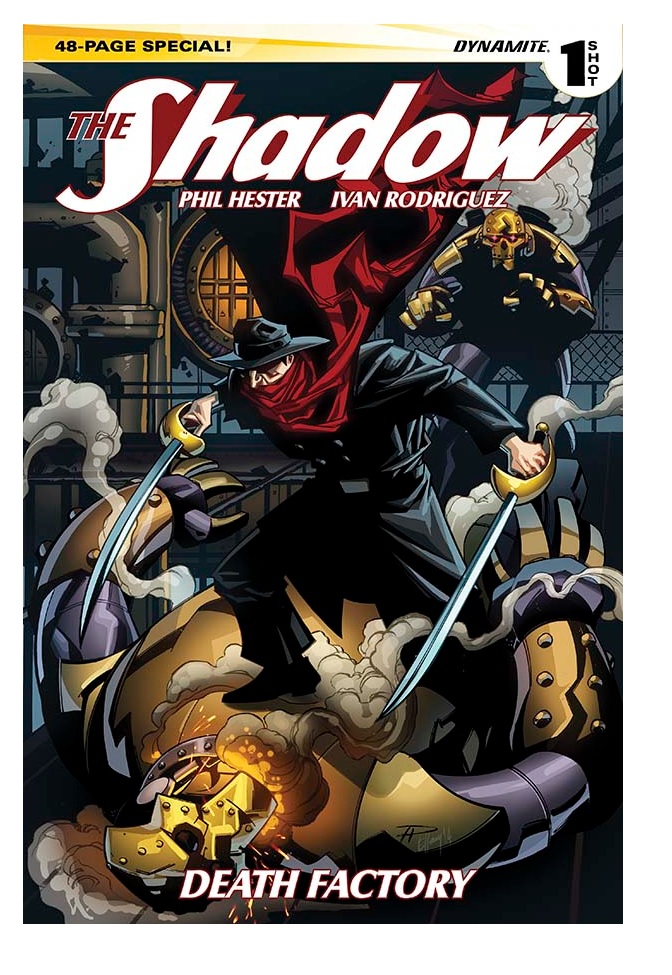
THE SHADOW: DEATH FACTORY #1
Writer: Phil HesterArtist: Ivan Rodriguez
Publisher: Dynamite Entertainment
Reviewer: Masked Man
Dynamite's roll out of rather pricy prestigious format one shots continues with one of The Shadow written by comic vet Phil Hester, who also drew the nice cover, and Ivan Rodriguez, who had been drawing THE SPIDER for Dynamite, handling the interior artwork.
First let's talk economics: this 48 page book is basically $8. That’s twice as much as a normal issue--in price as well as in pages, to be fair. Still, $8 seems rather high to me. No offence to Hester and Rodriguez, but they aren't really top talent (nor was the team working on the DOC SAVAGE One-Shot) to warrant an $8 purchase. In comparison, Dynamite's GRENDEL VS THE SHADOW crossover was 48 pages, featured Matt Wagner (I'd say he's a bigger star) and cost $6 an issue. Much more palatable and much more worth it.
Ok, let's get into the content. Phil Hester does a good job bringing The Shadow to life here, and enjoys employing much of The Shadow's gang (the people The Shadow has saved on some level who now work for him). Continuity fans will appreciate the nod Hester throws in to the current JUSTICE INC. miniseries, which features The Shadow. I often think continuity is a double-edged blade--it can screw things up just as much as make things better. Overall, I think it's a good thing that Dynamite is trying to build their 1930s world into a continuity. But it should never pigeonhole these characters down, who are, let's face it, bigger than Dynamite. Hester also plays with the different aliases of The Shadow, not just his most famous one, Lamont Cranston. In all, he does a decent job keeping The Shadow's world deep and rich in this mere 48 page story.
Getting into the spoilers, The Shadow runs afoul of a German WWI vet who is already preparing for WWII. He hopes to ruin America by inciting race wars by giving jobs to minorities over whites in The Depression. A decent enough idea, but sticking poison gas in the cars they make? I got no idea how that helps him. One of the Shadow's agents, Jericho Druke, an African American, works at the villain’s car plant and discovers his evil plan, so he takes off his shirt and tells all his coworkers they should run for their lives, which they do, even though he gives them no reason why—again, I don't understand the story logic. Overall I feel Hester should have made one more draft of this story. It's decent enough, but doesn't seem like it was left in the oven long enough.
Now, I haven't read THE SPIDER, so this is my first time really seeing Ivan Rodriguez's artwork. Overall he has some fine figure work and reasonable storytelling skill, even though there were a few panels where I had no idea what was happening in them. And, as I've said before, I'm not a fan of CGI effects in comics (unless the whole thing is CGI). Rodriguez uses a ton of CGI backgrounds and objects, and it just looks like bad TV animation from the 90s, poorly blending two styles. If you are going to use CGI effects and props, you must use them as guides, not as final product. John Byrne has used CGI cars and the like for years now, but he draws over them-he doesn't just stick a CGI car into a panel.
So this book is a mix of good and bad, though the good outweighs the bad--until you think about the $8 price tag. Then it's a buyer beware--as in don't oversell this in your head, as you maybe disappointed. Because on the Masked Man's scale of CRAP, POOR, DECENT, GOOD, and GREAT, it scores a DECENT.

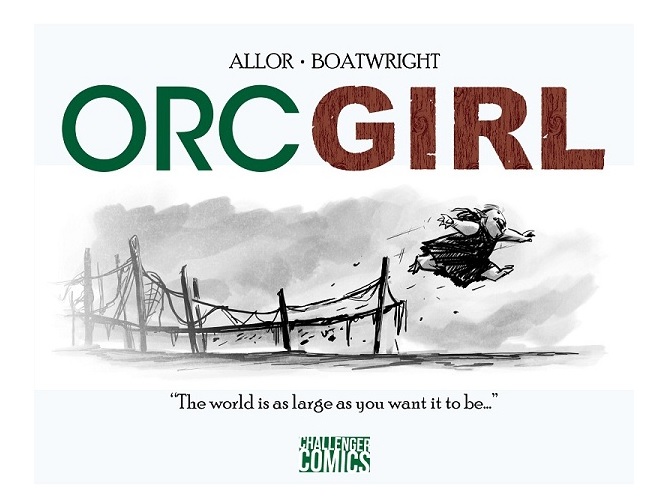

ORC GIRL One Shot
Writer: Paul AllorArtist: Thomas Boatwright
Publisher: Challenger Comics
Reviewer: Morbidlyobesefleshdevouringcat
Upon first look ORC GIRL appears as though it might be a childrens’ book. Flipping through you’re going to find simple artwork--dreamy dark watercolors pasted across rough, sketchbook-like lines. The characters, evidently orcs, are wide-faced and slightly cartoonish. Even the cover stirs something meant for a younger audience with what appears to be a young female orc, her mouth agape with what you’re assuming is a smile as she races across a bridge. Below her sits a quote: “the world is as large as you want it to be…” It’s all reminiscent of a Shel Silverstein book, but what writer Paul Allor and artist Thomas Boatwright execute here is a complex piece of literature depicting the human condition.
Fern, a young orc brimming with copious amounts of curiosity, takes the need to satisfy her wanderlust into her own hands and decides that a river adventure would best sate her desires. Accompanied by her younger brother Bogar, who determines that it is his duty to protect his sister, the two build a raft to steer towards whatever wonders may lie beyond their small Orc town. In doing so, Bogar is lost to the river where he drifts to the other side where the humans reside, and with the turbulent relationship that the Orc and the humans have, Fern finds out that there is no way of returning him home.
The weight of Fern’s guilt is emphasized through Boatwright’s simple poignant details. In a straight ahead panel of Fern her face is darkened; only the details of her large orc teeth are visible and rather than draw the background of her whereabouts, a sort of funeral procession for Bogar, Fern’s surroundings are grey with very large black scratches. It’s disheartening to look at, to only imagine what she must be feeling. It’s heavy--really, really heavy. This is just a single example of Boatwright’s incredibly emotive art, and what garners the intrinsically powerful emotions that ORC GIRL subdues from its readers.
The comic then continues to narrate the guilt experienced by Fern, and is also where Allor’s talent with lyrically heavy monologues shines. The wording is short, simple but holds true as Fern learns to grow and move on, unintentionally forgetting about her brother, and even finds herself settling down. Fern unexpectedly discovers that she’s happy as the life she had imagined for herself shifts into what she supposedly never wanted.
Not near close to the end, but definitely not wanting to ruin the story itself I’ll just end with this: ORC GIRL encapsulates the term ‘sequential art’. It demonstrates how words and pictures come together to create the experience that is truly, uniquely comics, and is a prime example of the talents and potential that both Allor and Boatwright contain. ORC GIRL is powerful in its nuances and depiction of the turbulent effervescence of growing up. And, as a comic that easily be enjoyed by anyone and everyone, I sincerely hope it is a comic that you find landing in your hands soon.
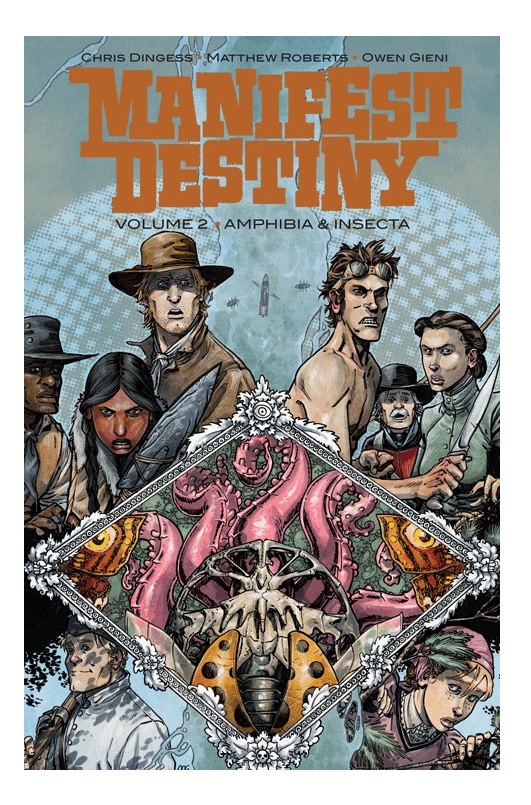
MANIFEST DESTINY VOL. 2: AMPHIBIA & INSECTA
Writer: Chris DingessArtist: Matthew Roberts
Publisher: Image Comics
Reviewer: Humphrey Lee
Sometimes I find myself being a sucker for the old “it’s this meets this” quick pitch, mash up material, depending on what it is, of course. Now, I’ve stated before here that I had that as a generic description of a book or movie or what have you because that tends to be lazy (for people doing review work like this, anyways) but sometimes that’s just what a particular work has going for itself. Sometimes you get Nazi zombies, other times you get Nazis on the Moon… well, okay, a lot of times these things usually just get Nazis combined with whatever a dart happens to hit on a corkboard list. Regardless, you occasionally get works like MANIFEST DESTINY here, where this takes a real thing that actually happened AND WASN’T NAZIS!!! and turns it into some grand unexpected adventure by slamming it into something unconventional and making it work. Even better, we’re now on the second trade collection and it has yet to falter.
MANIFEST DESTINY, for those not familiar with the title, is the grand expedition of Lewis and Clark into the New Frontier but by the way of Peter Jackson’s “King Kong” where there are jungles full of nasties trying to kill all involved. That’s right, the Thomas Jefferson-administered exploratory team sent out to chart and report on the greatest expanse this country has ever seen finds itself mostly trying to not be slaughtered by creatures like you see in all the movies that the “Mystery Science Theater 3000” folks used to skewer. And it works because the way it is all presented, with a combination of “we obviously do not give any of the fucks” nonchalantness to how and what they throw at the discovery team interlaced with a completely serious tone about these encounters given the life and gruesome death scenarios they present. There’s an unwavering air of gallows humor that clouds the book that you just cannot help but be amused by and respect.
Take this volume, for example, which finds our expedition still startled and haggard from a first arc spent fighting bison-headed men and a plant growth that essentially turned people into zombies. The column is down a few of its original members (made of a mix of soldiers and indentured prisoners) because gruesome death, but up a handful of crewmembers absorbed from rescued members of an outpost. Where do you go from plant zombies and Bisonmen? You dive right into giant man-eating frog things and hand-sized mosquitoes that lay eggs inside of the hosts they draw blood from. And these natural selection hijinks lead to another sadistically enrapturing aspect of MANIFEST DESTINY where you get immense schadenfreude over watching some of these bastards die – because there are some true douches mixed in with the prison populace – but then sometimes feel just a wee bit bad about it because of how fucked up they either bite it or wind up down a limb or what have you. Except for the attempted rapist--he deserves everything he got and more and, yes, this book is willing to go there too even with its mostly tongue-in-cheek nature.
Really it’s just a case of good execution that pulls this book off. You get so wrapped up in the visceral nature of the killing entities put before our mostly intrepid but partially scared shitless heroes that you do not really think about the idea that this is taking place with real, once-living people in a very important historical endeavor. It becomes cartoonish until it slams you back into that realization, which makes it even more enjoyable because of the absurdity of it all. And it’s all pitch perfectly rendered by artist Matthew Roberts’ pencils and the color job Owen Gieni does with them. Roberts’ style is a highly detailed and realistic one with just enough exaggeration that it pushes all the horror and black humor moments just that extra bit forward. It reminds me very much of what Tony Moore brought to the table when he was all over the place at Image, particularly on his end of FEAR AGENT. And Gieni’s colors give it the vibrancy and lush palette a book that takes place mostly out in the wilds absolutely needs to pull you into the setting. Fantastic effort all around on the visuals for sure, and they make a great selling point for the book just with a casual flip-through.
MANIFEST DESTINY is highly enjoyable fanfare that has shockingly surprised me with how well it has handled somewhat tropey horror conventions in the setting it decided to take part. Admittedly, it’s a little plot light thus far, though, and that is maybe the one flaw I hope rectifies itself. As cool as the plot of “the guys who discovered America for us fight monsters!” has panned out so far, I’m hoping our creative team digs a little deeper into their own mythos in this world to start explaining all this weird shit. I mean, that could just be me and maybe all these shenanigans need no explanation and the modern day USA of this world is full of the Internet and bugs the size of cats (or shit, maybe the bugs are our domesticated creature of choice) but considering how relatively straight the scientific and physiological aspects of this book play out, I feel like it’s not a stretch to believe that this deadlier version of the Louisiana territories exists for a reason in this world. Regardless, between the quality of the life and death encounters, and the fear and drama and humor that MANIFEST DESTINY expresses within these incidents, this book should be positively teeming with daring and enthralling adventures for the foreseeable future.
Humphrey Lee has been an avid comic book reader going on fifteen years now and a contributor to Ain't It Cool comics for quite a few as well. In fact, reading comics is about all he does in his free time and where all the money from his day job wages goes to - funding his comic book habit so he can talk about them to you, our loyal readers (lucky you). He's a bit of a social networking whore, so you can find him all over the Interwebs on sites like Twitter, Facebookand a blog where he also mostly talks about comics with his free time because he hasn't the slightest semblance of a life. Sad but true, and he gladly encourages you to add, read, and comment as you will.
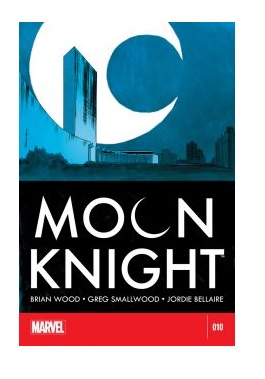
MOON KNIGHT #11
Writer: Brian WoodArtist: Greg Smallwood
Publisher: Marvel Comics
Reviewer: Masked Man
Marvel's latest critical darling continues to impress, even though it might be trying too hard. Now on their 5th issue, Wood and Smallwood (those names, seriously) are fully entrenched in a story arc--something series creator Warren Ellis steered clear of, but I assume Marvel can push Wood around more than Ellis to make MOON KNIGHT a more typical (safer, easier to market, easier to force readers back next month, easier to print as a trade) comic book product. But to be fair, you can follow the typical comic book marketing game plan and still have a good book.
Getting into spoiler territory, Wood has firmly set up Moon Knight's psychologist, just named Doctor (who did appear in Ellis' run), as the villain of this story arc. Or at least actively, as she would argue the African dictator she's been trying to kill is the real villain. This issue has Moon Knight, or rather Marc Spector himself, a prisoner in some pseudo government holding facility, thanks to his Doctor, basically being held until whatever powers that be deem him no longer worth holding. Wood and Smallwood, in keeping with the tone of the book, try to illustrate this predicament in as a unique way as they can, then giving us a cute reveal as Spector finally decides to try and escape (don't flip to the back, people!).
So the issue is pretty much what we've come to expect of this book. Something slower, something different, and something a little richer than your typical comic book. Almost like an indie movie, if you will, and you can take that as a good thing or a bad thing depending on what you think about indie movies (real ones, not low budget films starring A-listers looking for street cred). For myself, who found Wood's recent STAR WARS comic quite boring, I'm enjoyed this and am enjoying what he is building. My only fear is him being too straightforward with the conclusion and not addressing the greater moral ambiguity of the plot.
The one part of this book I'm conflicted with is Smallwood's art. Don't get me wrong, for the most part it's all really good. But I feel the originality created by Ellis and Declan Shalvey is forcing him (and Wood's script) to be unique just for the sake of being unique, as opposed to Ellis and Shalvey who used it to serve the story first and be unique secondly. Getting more personal, in my view this is still a superhero comic book, and I want my superheroes to look like superheroes. Smallwood's Marc Spector has a physique on par with my own, which is not right. Not that every superhero should look like an Ed McGuinness character, but they should be heroic looking. Another 10 or 20 pounds of muscle would be nice. That said, Greg Smallwood and colorist Jordie Bellaire are doing a fine job on this book.
So while some may still lament the loss of Ellis and the standalone issues, I feel Wood and Smallwood are doing a great job keeping the original feel, and growing the book as well. Since it has yet to crossover into any “Original Axis” or anything, MOON KNIGHT is still a small, simple, refreshing superhero comic, very much like Waid's DAREDEVIL or Azzarello's WONDER WOMAN (minus the retcon). Definitely worth checking out, especially the next issue where things should get pretty hot.
Proofs, co-edits & common sense provided by Sleazy G
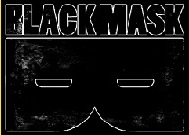 The next level of comic book excellence is a click away at BLACK MASK STUDIOS!
The next level of comic book excellence is a click away at BLACK MASK STUDIOS! Want more in all things Geek?
Want more in all things Geek?Check out our friends at PoptardsGo for podcasts, reviews, and more!
 And if you still need more geek in your life, check out Part-Time Fanboy for more geeky goodness on comics, movies, and more!
And if you still need more geek in your life, check out Part-Time Fanboy for more geeky goodness on comics, movies, and more!Finally, check out AICN COMICS on Facebook and Comixpedia!
